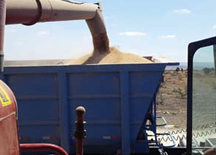Farm Machinery and Sustainable Agriculture Must Evolve Together
 Machinery’s role in an environmentally sustainable future is a main concern. Farm machines have revolutionized agriculture and reduced drudgery for millions of farm families and workers, but the machinery of tomorrow will have to do more than that – it will also have to contribute to agriculture that is environmentally sustainable.
Machinery’s role in an environmentally sustainable future is a main concern. Farm machines have revolutionized agriculture and reduced drudgery for millions of farm families and workers, but the machinery of tomorrow will have to do more than that – it will also have to contribute to agriculture that is environmentally sustainable.
There is need to explore the inexorable rise of the use of machinery in farmers’ fields, drawing lessons for policymakers and economists from some of the big winners and also the regions lagging behind. For example, Kenya went from using human muscle and ox power to being a mechanized agricultural economy in Africa, with low-power 2-wheel tractors, and diesel powered irrigation pumps and widespread mechanized crop threshing.
Comparatively, other regional countries, which have comparatively the most abundant land resources, have less than 10 percent of mechanization services provided by engine power. About 25 percent of farm power is provided by draught animals and over 60 percent by people’s muscles, mostly from women, the elderly and children.
There is need to draw lessons from these trends, with in-depth studies of mechanization in countries and regions in Africa, Asia, the Near East, South America and Eastern Europe, as well as chapters on themes such as development needs, manufacturing and information exchange.
There is also need to delve into many aspects of farm mechanization, not only how machines will contribute to an environmentally sustainable future, but also what policies will put machines at the service of family farms so that they too can profit.
Future of agriculture.
This investment should consider the future; arguably, the design of agricultural machinery must evolve in parallel with the roll out of Sustainable Crop Production Intensification (SCPI). That means fewer chemicals, more efficient use of water, and more efficient use of machines.
Farm machinery needs to be intelligent, lean, precise and efficient in order to minimize the impact on the soil and the landscape. Two of the farming activities that have the greatest impact on the environment are soil tillage, because it can severely damage soil ecology, and pesticide application.
Conservation agriculture is an approach that reduces or eliminates soil tillage and pesticide use. To control weeds, conserve soil moisture and avoid soil disturbance, a mulch layer of crop residue is retained on the unploughed field.
Special machinery is needed to plant seeds and apply fertilizer through the mulch at the correct depth without disturbing the crop residues. An added advantage to this type of mechanization is that, without the need for high-draught tillage, lower powered and therefore cheaper tractors can be used. These lighter machines have the added advantage of not compacting and therefore damaging the soil like a heavy tractor would.
The use of agrochemicals for the management of insect pests, disease and weeds can have a significant impact on the environment. Besides reducing pesticide use overall through integrated pest management including biological control, when chemicals are necessary they can be used with greater precision since it is estimated that about 50 percent of all pesticides applied do not reach their intended target. Many technological innovations exist to improve this situation, for example, low drift nozzles and spray shields.
In irrigation, technologies such as micro sprinklers or drip irrigation that save water and consume less power are the environmentally friendly way of the future, according to the book.
Defeating poverty
For proper mechanization for rural development, government policies should encourage the agricultural machinery sector to develop markets for agricultural mechanization, especially for conservation agriculture, and to establish the required infrastructures.
Such support, especially to the smallholder sector, can have a dramatic impact in moving farm families out of poverty into a more profitable, commercially oriented agriculture.
The global agricultural machinery industry should provide more support to smallholder farmers with equipment designs and models that better suit the needs of smallholder farmers and service providers.
Without this change in the machinery sector, the needs of developing countries for food security, poverty alleviation, economic growth and environmental protection cannot be achieved.